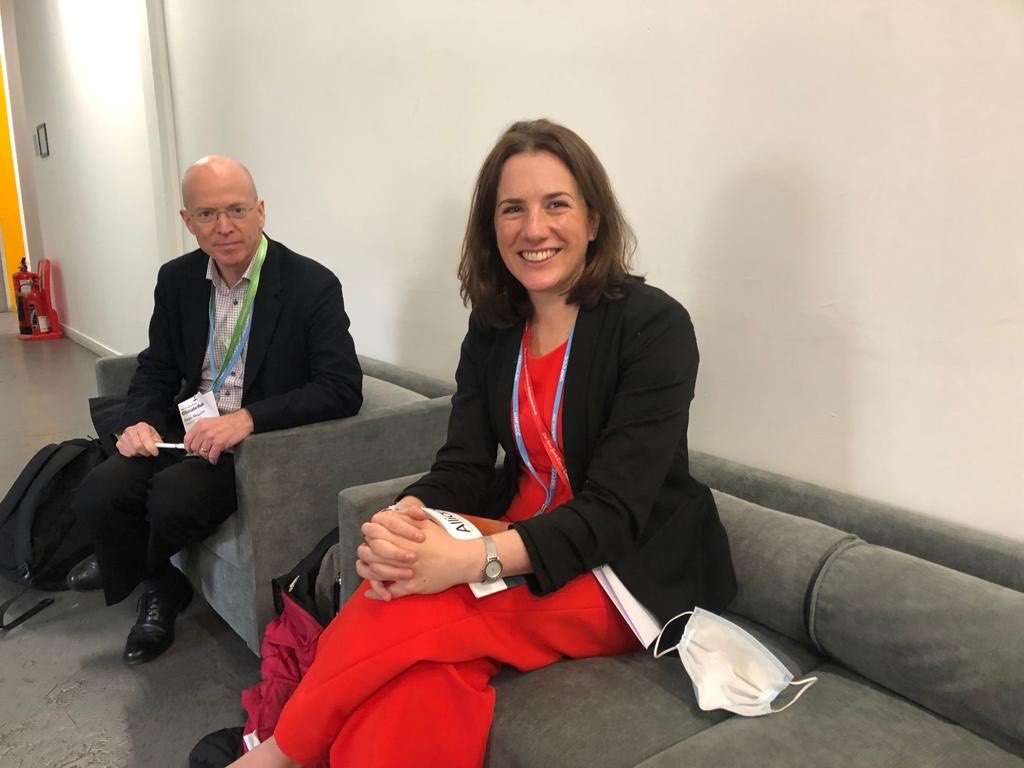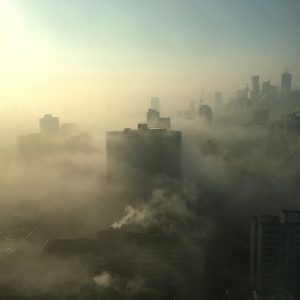So far, air pollution has ranked low down the list of climate priorities. Elika Roohi and Charles Keidan met Jane Burston and Sean Maguire of the Clean Air Fund at COP26 in Glasgow and asked them why and what they are doing about it.
Burston is the Executive Director of the Clean Air Fund, and Maguire is its Director of Strategic Partnerships and Communications. The Fund launched in 2019 with a goal of tackling the issue of air pollution and how it intersects with both climate and public health.

Clean Air Fund Executive Director Jane Burston and Director of Strategic Partnerships and Communications Sean Maguire at the New York Times Climate Hub in Glasgow
Elika Roohi: First of all, can you tell us about the corporate elements for Clean Air that you launched at COP26?
JB: We did a survey in the first few months of the pandemic and in a lot of different countries from Nigeria to India, UK to Poland, and everywhere, more than two-thirds of people said that they wanted stricter regulation on air pollution, and more than three-quarters said not only was air pollution one of their top three environmental priorities, it was also one of their top three health priorities, and this is in the first few months of the pandemic. The health evidence is very clear and it’s getting worse. Governments are starting to do something, but corporate action is very scarce, so we wanted to accelerate business action and partnered with the World Economic Forum to do that. There are ten businesses in the alliance including two Indian companies and an Indonesian company, which we were very pleased about. Often, you see climate alliances being led exclusively by western companies so having Mahindra, Wipro and Go To really shows that this is an issue that matters globally.
They’re committing to three things; first is measuring their air pollution footprint within the next 12 months, and once they’ve measured that baseline, to commit to a reduction target. That isn’t as easy as it might sound because there isn’t at the moment, a methodology for businesses to measure their air pollution footprint. Unlike greenhouse gases where a tonne emitted anywhere in the world is as bad as a tonne emitted somewhere else, pollution matters when it’s close to people and they get exposed to it, so we’re keen for the companies to track the health harms of their activities so that they can better prioritise climate action for health as well as climate. Ikea and the Stockholm Environment Institute have already started working on a methodology which the other companies are going to use. The second commitment is to champion action on air quality with stakeholders – employees, customers and other stakeholders, maybe governments and really mainstream the discussion about air pollution in their communications so that people see that air pollution and climate change can be tackled by some of the same actions. And the third commitment is to use the business’s special assets to further the cause. Examples that were given on the panel yesterday, are Ikea buying crops from farmers in the north of India that would otherwise have been burned and turning them into straw mats and other products. In the last few years, Google have started to monitor pollution using their street view vehicles. So we hope that they come up with many more examples at a much greater scale over the next years.
ER: Climate funding is a fraction of overall funding and clean air funding is a fraction of a fraction. You have only been running since 2019. Have you seen the needle move on funding for clean air in that short time?
JB: Yes, massively. As you say, it’s still a fraction of a fraction. If you look at the percentage increases over the last five years, they’re pretty big, but that’s because it was starting from a phenomenally low base. We’ve also looked at development aid as well as philanthropic funding and that’s also a very small number – less than one per cent of overall aid spending by the development agencies and those agencies are spending more money on projects that prolong fossil fuel use than reduce air pollution, 21 per cent in the last two years. We absolutely think that they need to stop doing that and create new finance for air pollution because it tackles so many things at once. I think this is why foundations are starting to look more closely and increase the funding for pollution. Because tackling climate change is supporting better public health.
CK: Who were your initial funders?
JB: There were six initial donors who collectively provided $50 million for our launch in 2019, and they were CIFF, the Ikea Foundation, Bernard van Leer and Oak Foundations, Guy’s and St. Thomas’ and the FIA[1] Foundation. FIA is a small foundation focused on sustainable mobility based in the UK, but its funding is global. Historically they’ve worked on road safety and have moved on to sustainable mobility. Since then, ELMA and Bloomberg have come on board and we have received some project-level funding from Wellcome. The rest of them contribute to the pooled fund, which is now $57 million in total.
CK: How and why is money from development aid agencies supporting fossil fuel exploitation?
JB: One example is the Medupi coal-fired power plant in South Africa, into which some $2.64 billion went. Some research came up with the statistic that says it’s killing 364 people every year. Some of this is errors in the implementation of the project. There were supposed to be remediation measures built into the original project so that the pollutant wasn’t as bad that never happened, so what’s happened is different from the original intention. The project implementers argued that it would be quicker to build a coal-fired power plant than renewable energy and that it was therefore important for development. So it’s one form of development conflicting with another. One of the things that we found with development agencies is they do have an appetite to work on air pollution but often, there’s a climate budget and there’s a health budget and if you are on the health side, there’s no means of reporting greenhouse gas reductions from the projects that you funded and the same goes the other way round if you’re on the climate side, so there are metrics issues getting in the way.
Another thing that people don’t often think about when they think about pollution but which is really another element of the inequity of pollution is its effects on children’s education. This is because children have their brain development hampered by breathing air pollution or because their mothers are breathing air pollution before they are born, and also because of the short-term cognitive effects of being poisoned and therefore, being unable to concentrate. A study last year by the University of Manchester found that, if the outdoor air pollution around schools in Manchester were reduced by 20 per cent, kids’ memories would improve by 6 per cent, which is the equivalent of four additional weeks of education every year. If you think about the impact of that on equity, the schools that are the most polluted are likely to be the ones in low-income neighbourhoods, next to a busy road or an industrial facility, or to not have air purifiers in countries where they’re required so those children face an even greater struggle to get themselves out of poverty because their education is seriously affected. Air pollution brings together so many different issues of climate, health, equity, education, and I think that that’s why foundations, especially early childhood development and health foundations are getting more involved.

Photo credit: Unsplash
ER: Some of these statistics about how unhealthy pollution is are really striking. What we can do to raise it as an issue?
JB: The parents’ groups who are here at the COP are doing a fantastic job. They and the Clean Air Fund and an organisation called Campaign Collective have put together a website called Our Children’s Air, where parents and children from around the world can relate their stories about being affected by pollution. There are stories from Uganda and the estates in India, and the heartbreaking stories that are on there that the mothers also related in the panel. There was one story from a mum in Montana, about how she and her husband have to keep their kids indoors because of the wildfires they are having as a result of climate change and she wrote that their 18-month-old girl stood at the door holding her shoes crying because she wants to go out and she doesn’t know why they’ve shut her in. You can back those human stories with evidence from doctors and health professionals who have got the statistics at their fingertips.
ER: As one of your reports points out, clean air is one of the more non-political issues in the climate space and it tends to attract funders who want to do something about climate but don’t want to be political. Have you seen that kind of support for your work?
JB: What has been interesting is that three of our funders had never funded climate or environmental issues before they funded us and I think that could be one of the reasons. The three are the ELMA Foundation, Bernard van Leer and Guy’s and St Thomas’ charity, which I think they just renamed Impact on Urban Health. It was through their Urban 95 programme where clean air kept coming up as an issue for early childhood development.
ER: What are some other insights that you want philanthropy to pay attention to when it comes to clean air?
JB: The intersectionality of it, and the fact that it’s a rights issue too. We don’t currently have any funders that are investing in rights issues, but those kinds of funders absolutely should be investing in the issue given the number of NGO groups calling for clean air as a human right. And of course, the health and early childhood dimension should attract funders, too.
SM: What we did find was that the share of funding by health foundations was quite small given the impact of air pollution on health.
CK: Why is that?
SM: I think part of it is that there are a lot of health challenges, so there’s plenty of things that health foundations can fund, things like vaccines, malaria, tuberculosis, that a physician would recognise as a primary health issue. But if it’s a kind of second-order problem, like an environmental health or public health challenge, it’s sometimes harder for them to see how their money can make a difference. Some of the more far-sighted foundations get it but I think we as an organisation need to do more research in this area.
One of the things that’s interesting is that health organisations have been pushing to get health recognised as a climate issue. The WHO, for instance, has its own pavilion here at COP for the first time and there are many more campaigners and activist groups here saying climate change is a health issue and air pollution is at the heart of the health impacts of climate change; if you burn fossil fuels you create climate change but you also create air pollution. The problem’s the same, the solution’s the same. We now wait to see whether it actually get into any of the texts that come out of COP.
JB: We saw in the UN FCC synthesis report that looked at all of the nationally determined contributions that seven per cent of those NDCs now consider the impact of short-lived climate forces which are some of the pollutants that are harmful to health as well. So it’s sneaking in on a small scale.
CK: And how are conversations going with those health funders that you want to get on board?
JB: As Sean says, health funders have been slower to come to this issue, but they’re starting to come on board. Guy’s and St Thomas’ announced quite a large investment into the issue in general and the Wellcome Trust climate and health programme is due to start imminently and it seems like air pollution is going to be part of that, so some important health funders are starting to think in a more systemic way about non-communicable diseases.
ER: What else is the Clean Air Fund doing at COP?
JB: We are trying to draw attention to the impact of pollution on children in particular. We’ve funded some of the activity with the mothers’ groups and they handed a letter to Alok Sharma this morning, asking for an end to investment in fossil fuels, because of the impact on their children’s health. We also have funded a group of doctors and nurses that work at children’s hospitals and who started a cycle ride from Great Ormond Street Hospital in London and have ended up at the COP, visiting different children’s hospitals throughout the country on the way and talking to them about the impact of air pollution on children’s health. With the doctors, too, we’ve set up the pollution pods. They’re like greenhouses in which the artist has simulated pollution from five different cities, and they’re here in Glasgow. One of them represents the pollution in Delhi, one in São Paulo, one in London, for example. The whole campaign involving the doctors is called Ride for their Lives.
ER: Do you feel generally positive about what you’re seeing coming out of this COP?
JB: There’s nowhere near enough action on tackling climate change and air pollution together as one issue rather than separately. The stat to back that up is the one I quoted earlier – only seven per cent of governments have even considered that in their NDCs. So no!
Footnotes
- ^ FIA is the Federation Internationale de l’Automobile, the governing body of world motorsports, including Formula 1 and the World Rally Championship


Comments (0)